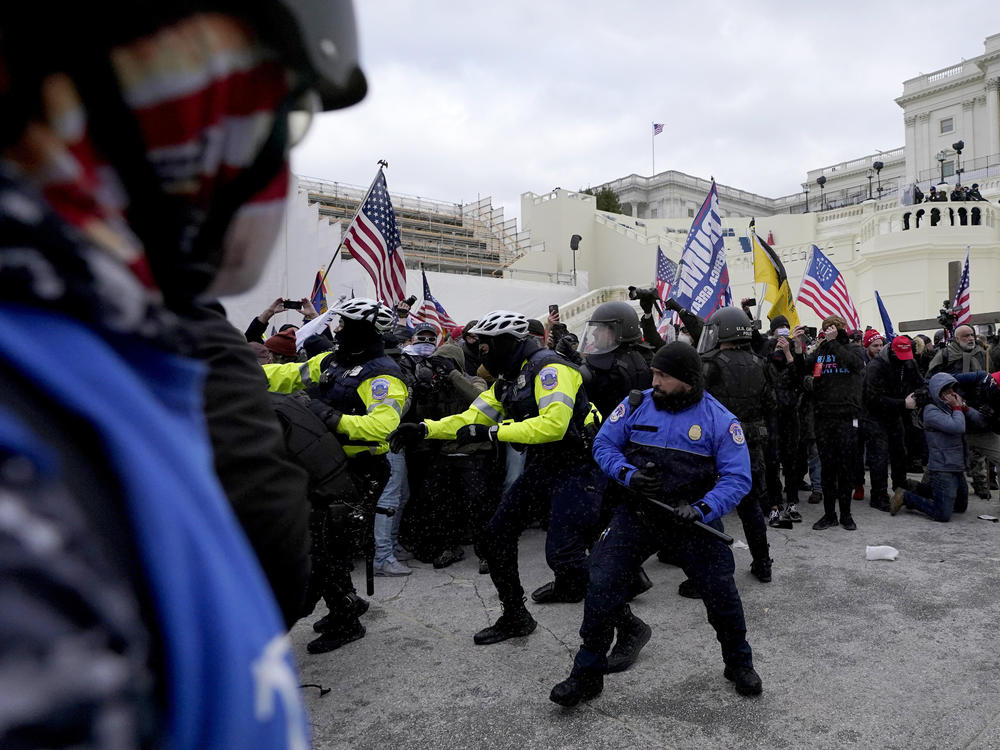Section Branding
Header Content
2 Capitol Police Officers Sue Trump For Injuries Sustained During Jan. 6 Riot
Primary Content
Two U.S. Capitol police officers are suing former President Donald Trump, for allegedly inciting the riots that took over the Capitol building Jan. 6.
Officers James Blassingame and Sidney Hemby argue in court documents reviewed by NPR that Trump is responsible for the physical and emotional injuries the officers received following the violent riots at the Capitol. The insurrection resulted in the death of five people.
The lawsuit details the violence Blassingame and Hemby faced during the Jan. 6 attack, as well as the physical and emotional toll they continue to deal with.
Lawyers for the officers argue Trump's repeated false claims over several months that the 2020 presidential election could be stolen or was eventually "rigged" motivated the eventual insurrectionists.
Trump "inflamed, encouraged, incited, directed, and aided and abetted" the "insurrectionist mob" to force its way into the Capitol building to stop the certification of the election on Jan. 6. The mob "forced its way over and past the plaintiffs and their fellow officers, pursuing and attacking them inside and outside the United States Capitol, and causing the injuries."
The lawsuit says Trump is liable for the injuries the plaintiffs and other Capitol Police and Metropolitan Police Department officers sustained that day.
Court documents include pictures of Trump's Twitter posts and statements the former president made during the 2020 campaign questioning the integrity of the U.S. election system.
The officers are seeking unspecified monetary damages with the lawsuit. Documents say the "amount in controversy exceeds $75,000, not counting interest and costs."
Emotional, physical damage remain
According to the lawsuit, Blassingame was thrown against a stone column as a mob of people rushed into the Crypt of the U.S. Capitol on Jan. 6. He hit his spine and the back of his head and was unable to move for a period of time. He was called racial slurs by the attackers and was hit repeatedly, according to court documents.
Blassingame was one of eight or nine officers who attempted to protect the Crypt as the mob filled the area, according to the lawsuit.
Once he was able to flee to safety, Blassingame remained locked in the House Ways and Means Committee room with members, some of whom were unmasked for hours.
The lawsuit states, "Officer Blassingame was acutely aware that many in the Ways and Means room were neither masked nor socially distanced from Covid-19 transmission. He had no option but to remain in place."
As Hemby sought to protect the Capitol, he was sprayed in the face and body with chemical irritants that burned his skin.
The lawsuit said Hemby was "crushed against the doors on the east side trying to hold the insurrectionists back. Over and over, he tried to tell the insurrectionists that the doors opened outward and that pressing him into the door would do no good."
Both Blassingame and Hemby continue to deal with the emotional fallout of the attack. The lawsuit, filed in Washington, D.C., says Blassingame is haunted by the memory of being attacked and remains triggered by the sights, sounds, smells of the events that day.
"The weight on Officer Blassingame has been heavy and pervasive. He was not able to sleep and he could not talk about what happened, even with his wife and friends," the lawsuit states.
Hemby still has damage to his left hand and knee as well as his neck and back that requires regular physical therapy.
The lawsuit states, "He continues to sleep poorly and feels hyper-aware and on high alert during his waking hours."
Copyright 2021 NPR. To see more, visit https://www.npr.org.

